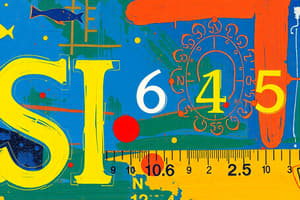Podcast
Questions and Answers
What is the unit for a plane angle represented by?
What is the unit for a plane angle represented by?
- steradian
- degree
- radian (correct)
- arcsecond
Which of the following statements about solid angles is true?
Which of the following statements about solid angles is true?
- The unit for solid angle is steradian. (correct)
- Solid angle is measured in degrees.
- Solid angle is represented by the symbol rad.
- Solid angle is defined by the ratio of intercepted area to the cube of the radius.
What defines the SI unit of length, the metre?
What defines the SI unit of length, the metre?
- It is based on the wavelength of a specific color of light.
- It is equivalent to 100 centimeters.
- It is defined by the dimensions of a physical object.
- It is defined by the fixed numerical value of the speed of light. (correct)
Which of the following is incorrectly paired with its SI unit?
Which of the following is incorrectly paired with its SI unit?
What is the purpose of using significant figures in scientific measurements?
What is the purpose of using significant figures in scientific measurements?
Which of the following is NOT a derived SI unit?
Which of the following is NOT a derived SI unit?
How is a steradian defined in relation to its radius?
How is a steradian defined in relation to its radius?
Why are angle measurements in radians considered dimensionless?
Why are angle measurements in radians considered dimensionless?
What symbol represents the SI unit of time?
What symbol represents the SI unit of time?
What is the main characteristic of dimensionless quantities in the SI system?
What is the main characteristic of dimensionless quantities in the SI system?
Study Notes
Significant Figures
- Measurement results should reflect their precision; reported digits include both certain and uncertain figures.
- Example: 287.5 cm has four significant figures where 2, 8, 7 are certain, and 5 is uncertain.
- Reporting with excessive digits can mislead about measurement precision.
SI Derived Units
- Special names are assigned to certain derived SI units.
- SI units can utilize these specially named units alongside seven base units.
- These concepts are further explained in referenced appendices.
Measurement Systems
- Three primary systems of units:
- CGS (centimetre, gram, second)
- FPS (foot, pound, second)
- MKS (metre, kilogram, second)
- The Système Internationale d'Unités (SI) is the internationally accepted system, revised in November 2018.
SI Base Units
- There are seven base units in the SI system, which are essential for scientific measurement.
- The definition of:
- Length: metre (m), based on the speed of light in a vacuum.
- Mass: kilogram (kg), based on the Planck constant.
- Time: second (s).
Additional Units
- The SI includes two additional dimensionless units:
- Plane angle: radian (rad), defined as the ratio of arc length to radius.
- Solid angle: steradian (sr), defined as the ratio of the intercepted area to the square of the radius.
Conversions and Guidelines
- SI uses a decimal system, making unit conversions straightforward.
- Guidelines for significant figures and unit symbols are outlined to ensure clarity in measurements.
- Changes in units do not affect the count of significant figures in measurements.
Studying That Suits You
Use AI to generate personalized quizzes and flashcards to suit your learning preferences.
Related Documents
Description
Test your knowledge on significant figures, measurement systems, and SI units in this engaging quiz. Understand the importance of precision in measurements and the different systems of units used in scientific contexts. Challenge yourself with questions related to derived and base units as well.




